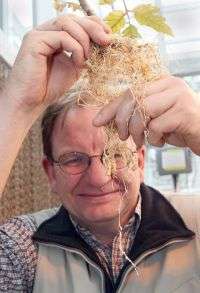Soybean varieties viable in southern Indiana, resistant to root-knot nematode

Purdue University researchers have identified several soybean varieties that grow well in areas of the Midwest like southern Indiana and are resistant to root-knot nematodes, a plant-destroying parasite with a recently confirmed presence in that part of the state.
The researchers verified that resistance in soybeans to one nematode parasite doesn't predict how well the plant will fight off another nematode species, said Andreas Westphal, assistant professor of plant pathology. Some of the varieties also were resistant to soybean cyst nematode.
"We were trying to identify soybean lines that will grow in Indiana and are root-knot nematode resistant," said Westphal, who is senior author of the report published online in the journal Crop Science and will be published in the March-April print issue.
The research team recently published a paper in Plant Health Progress that details the distribution of root-knot nematodes on soybeans in southwestern Indiana.
"We also wanted to find varieties that are nematode-tolerant," Westphal said. "In other words, the nematode is present in the soil, but the plant doesn't suffer a lot of damage."
Root-knot nematodes, including the species Meloidogyne incognita, infect soybeans in sandy loam soil and also reproduce on corn and the highly root-knot nematode-sensitive watermelon, two other major cash crops in the southern part of Indiana. The area, along with additional parts of the state, also suffers from other nematodes, including the soybean cyst nematode (Heterodera glycines). Root-knot nematodes are responsible for a loss of 93,000 tons of soybeans annually in the United States.
Other than resistant and tolerant plants, available methods to rid fields of the destructive organisms are not always practical or economically feasible, Westphal said. For example, chemicals that are effective against nematodes can be dangerous to the environment, people and animals.
A major concern for farmers is that soybeans, corn and watermelon are all susceptible to root-knot nematodes. Most farmers in southern Indiana plant crops in a soybean-corn-watermelon rotation. If the parasites infect the soybeans, then the organisms will be in the soil and can damage the subsequent crops planted in the same field.
"The availability of nematode-resistant varieties is important, not only for soybean production, but also for the whole rotation sequence because a resistant soybean crop will reduce the number of nematodes in the soil," Westphal said.
The study involved planting eight soybean strains in a commercial field near Vincennes, Ind. These were plant varieties that already were known to grow well in soil and weather similar to that found in southern Indiana. The field had a history of root-knot and soybean cyst nematode infestations. Westphal and his team also tested some of the same soybean lines in a field in which they introduced the nematodes and in a greenhouse where they used similar soil containing the root-knot nematodes.
Using plants known to be resistant to soybean cyst nematode, the researchers confirmed resistance to that nematode doesn't predict how resistant the plant will be to root-knot nematodes.
Although Indiana farmers previously were aware of the damage to their crops from soybean cyst nematode, it was only recently that they learned about root-knot infection of soybeans. They now know how to identify both nematodes and how these parasites damage crops.
Damage by plant-parasitic nematodes usually appears in patches in fields because where nematodes are introduced determines the infestation area. The type of soil and environmental conditions also play a role in the parasite's survival.
Both the soybean cyst and root-knot nematode feed on roots, robbing the plant of needed nutrients and water. The lemon-shaped soybean cyst nematode is easy to spot on the root because it stays on the outside. These pinhead-sized nematodes are white, then yellow, and finally become brown as they mature. The nematode-induced cysts are much smaller than the so-called "nodules," which are structures induced by the beneficial bacterium rhizobium. Rhizobium association aids the plant in nutritional nitrogen absorption.
The root-knot nematode induces big clumps, or galls, on the root that look a bit like a wart or a tree knot, and the deformations are much bigger than the signs caused by the soybean cyst nematode. The nematode galls have irregular tumorlike shapes, in contrast to the spherical shape of nodules caused by rhizobium association.
Next the researchers will try to determine varieties of cover crops that are nematode-resistant. Cover crops are used over the winter to control erosion but can provide a habitat for the parasites. This means that larger populations of the parasites are present when crops are planted in the spring.
"We hope that we can improve nematode suppression in the entire crop sequence to improve the yield of the cash crops," Westphal said.
Source: Purdue University















